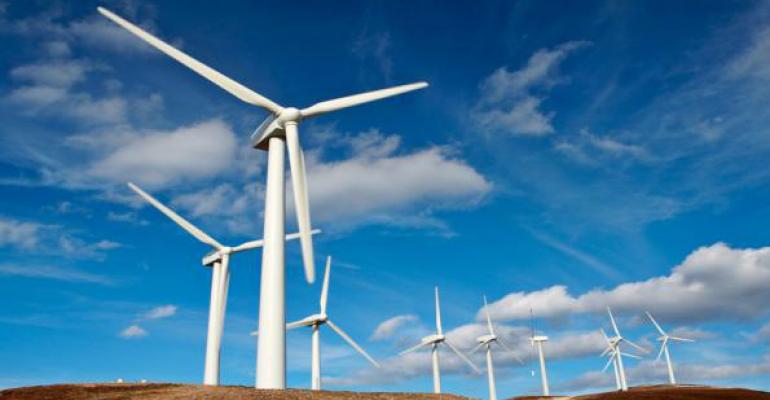(Bloomberg Markets)—After years of building an industrial real estate business in Puerto Rico, the older members of Raoul Slavin Juliá’s family were ready to sell their assets and retire. It was 2004, years before the island would face the back-to-back-to-back blows of bankruptcy and two destructive hurricanes, but it seemed like a good time to have a bit of liquidity.
“We looked around and said: What now?” Slavin Juliá, 46, remembers. What he saw on the island were crippling electricity costs and dependency on fossil fuels. The answer to his question, he eventually determined, was blowing all around him. His family would soon start on a journey to become builders and owners of wind farms in Puerto Rico and later the mainland U.S.
When he first looked for investment opportunities, in 2007, he discovered why wind farm ownership was the province of utilities: The education process takes years. Due diligence resembles that of industrial real estate, but clean-power plants often require a different sort of financial and regulatory sophistication. “I have never run across another family office competing” for a wind farm, says Slavin Juliá, who is a director of single-family office Treehouse Investments LLC. (The family’s concern about sea levels rising from climate change inspired them to name the business after an elevated house, he says.) The family office owns wind farms through subsidiary Aspenall Energies LLC.
Slavin Juliá’s family built its first wind farm in 2009, a two-turbine facility to power a local Bacardi rum factory. With that success, it looked a couple of years later for opportunities on the U.S. mainland, opting to purchase a newly completed farm for its first utility-scale project. “A family entering now in any U.S. state will find there is a rigorous framework, with a few exceptions,” Slavin Juliá says.
Why did Slavin Juliá’s family choose wind? Well, first, there’s the broad appeal of renewables. Operating wind and solar farms typically benefit from long-term contracts with investment-grade utilities. They tend to perform well, so there’s a high probability of steady, decadeslong revenue. It’s the type of investment that’s now attracting institutional investors such as pension funds and insurers—and appeals to climate-focused family offices such as Treehouse. “If you expect a decent rate of return and your vision is multigenerational, then those two perspectives coincide,” Slavin Juliá says.
The reason for investing in wind instead of solar was mostly situational. Treehouse would consider solar today, he says. In the mid-2000s, however, solar had yet to crack the U.S. mainstream and faced high insurance costs in hurricane-prone Puerto Rico, says Anne Amanda Bangasser, a Treehouse director and Slavin Juliá’s sister-in-law.
One early advantage Treehouse had in getting into the wind business was the specific expertise family members had to handle much of an operating plant’s needs. Slavin Juliá’s background is in law, Bangasser is an engineer, and Slavin Juliá’s wife is an accountant. Still, when the family first decided to invest in a utility-scale wind farm, they didn’t feel comfortable enough to build one from scratch and wanted something that was already “spinning,” Slavin Juliá says. “We thought: Let’s have our first project be one that has already gone through the construction process,” he says. “That way, we can be an asset owner and we can get some experience.”
Over the years, Treehouse built up a renewables network. Family members attended trade shows and engaged consultants in the years they spent building the Puerto Rico wind farm and planning others there. They had something specific in mind: a modest-size utility-scale farm that employed members of the community benefiting from it. They vetted projects in the U.S. and even Europe. Eventually a consultant referred them to a competitive auction for a 20-megawatt farm in Minnesota that had been in operation for several years.
The family won the farm and closed the deal in 2015. They tended to the farm for a while before they felt ready to break ground and actually construct a utility-scale plant. They have since built a 13MW farm in Minnesota and are erecting a 30MW project in Nebraska.
Owning—but not operating—a wind farm can be very desirable to passive investors, given the promised cash flows. But for those who want to build a U.S. project, they’ll need to find a plot of land, obtain permits and address typical Nimby pushback, select a turbine manufacturer and contractor, and arrange financing. That last part can be the trickiest, as financing incentives for renewables in the U.S. rely on esoteric lines of tax code that may create complications for small developers.
For its next investment, Treehouse, which now has offices in New York and Minneapolis, is looking at repowering older wind farms. This involves upgrading turbines to give plants built in the 1990s and early 2000s a second life. Looking back, Slavin Juliá says building up Treehouse’s portfolio wasn’t easy, but he sees wind farms as one of the best tangible investments a family office can own. “Definitely better than yachts, I can assure you,” he says.
Eckhouse is an energy reporter at Bloomberg News in New York.
To contact the author of this story: Brian Eckhouse in New York at [email protected]
COPYRIGHT
© 2018 Bloomberg L.P

